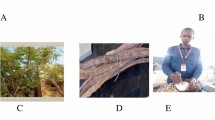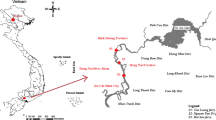Abstract
The world has a water deficit, mostly located in developing countries. For example, in Colombia, water deficit is a major concern and it increases in rural areas, where the rate of accessibility to drinking water is of 33.26 % in 2005. Since the 1970s, the most used technology for water purification is the conventional physicochemical process. The most common coagulant used in this process is aluminum sulfate (alum). This study focuses on a comparison between Moringa oleifera seeds and alum for water treatment in different natural waters. Results showed that M. oleifera removed 90 % turbidity and alum 96 % from water samples from the tested natural brook. However, color removal for M. oleifera was 95 and 80.3 % for alum. For water-polluted samples, both coagulants have shown high efficiency (100 %) in color and turbidity removal. Usage of natural coagulants (i.e., M. oleifera) instead of chemical ones (i.e., alum) are more convenient in rural areas where the economic situation and accessibility of those products are key elements to maintain fresh water treatment standards. Additionally, results demonstrated that high dosages M. oleifera did not affect the optimal value in terms of color and turbidity removal. In rural and developing countries, this is important because it does not require a sophisticated dosing equipment.




Similar content being viewed by others
References
Arantes, C. C., Ribeiro, T. A. P., Paterniani, J. E. S., Tateoka, M. S. S., & Silva, G. K. E. (2014). Use of natural coagulants based on Moringa oleifera and Tannin as filter aids for non-woven synthetics fabrics. Engenharia Agrícola, 34(4), 780–788.
Bhuptawat, H., Folkard, G., & Chaudhari, S. (2007). Innovative physico-chemical treatment of wastewater incorporating Moringa oleifera seed coagulant. Journal of Hazardous Material, 142, 477–482.
Beltrán Heredia, J., & Sánchez Martín, J. (2008). Azo dye removal by Moringa oleifera seed extract coagulation. Coloration Technology, 124(5), 310–317.
Campos, J., Colina, G., Fernandez, N., Torres, G., Sulbaran, B., & Ojeda, G. (2003). Caracterización del agente coagulante activo de las semillas de la Moringa oleifera mediante HPLC. Boletin del Centro de Investigaciones Biologicas, 37(1), 35–43.
Cardoso, K. K. (2013). Coagulation diagram using the Moringa oleifera Lam and the aluminium sulphate, aiming the removal of color and turbidity of water. Acta Scientiarum, 35(3), 112–120.
Castillo, J., Bracho, N., Vargas, L., Romero, N., & Aldana, G. (2000). Coagulant selection for water treatment process in Plant “C”, Maracaibo, Venezuela. Revista Tecnica de la Facultad de Ingenieria, 23(3), 172.
DANE. (2008). Encuesta calidad de vida 2008. Bogotá:DANE.
DAP-SISBEN. (2001). Indicadores nacionales y departamentales. Sostenibilidad y Medios de Vida. Gobernación de Antioquia, Antioquia. Medellin:DAP-SISBEN.
Flaten, T. P. (2001). Aluminium as a risk factor in Alzheimer’s disease, with emphasis on drinking water. Brain Res Bull, 55(2), 187–196.
Francisco, J. P., Silva, J. B. G., Roque, O. C. C., Nascentes, A. L., & Silva, L. D. B. (2014). Evaluation of the effect of the seed extract of Moringa oleifera lam over the efficiency of organic filters in wastewater treatment of dairy cattle breeding. Engenharia Agrícola, 34(1), 143–152.
Franco, M., Silva, G. K. E., & Paterniani, J. E. S. (2012). Water treatment by multistage filtration system with natural coagulant from Moringa oleifera seeds. Engenharia Agrícola, 32(5), 989–997.
Garcia, F. B. (2007). Metodologia de extracción in situ de coagulantes Naturales para la clarificación de aguas superficiales. Aplicación en paises en via de desarrollo. Tesis de grado, Valencia-España.
Ghebremichael, K. A., Gunaratna, K., Henriksson, H., Brumer, H., & Dalhammar, G. (2005). A simple purification and activity assay of the coagulant protein from Moringa oleifera seed. Water Research, 39(11), 2338–2344.
ICONTEC. (2010). Norma Técnica Colombiana NTC 3930. Procedimiento para el ensayo de coagulación—floculación en un recipiente con agua o método de jarras. Bogotá: ICONTEC.
Jadhav, M. V., & Mahajan, Y. S. (2014). Assessment of feasibility of natural coagulants in turbidity removal and modeling of coagulation process. Desalination and Water Treatment, 52(31–33), 5812–5821.
Ledo, P. G., Lima, R. F., Paulo, J. B., & Duarte, M. A. (2009). Estudio Comparativo de Sulfato de Aluminio y Semillas de Moringa oleifera para la Depuración de Aguas con Baja Turbiedad. Información Tecnologica, 20(5), 3–12.
Libhaber, M. (2008). Appropriate technology for wastewater treatment and reuse of effluents for irrigation. Seminario Interamericano Sobre Manejo de Vertimeintos Líquidos para Contribuir a la Mitigación del cambio Climatico, 1–33.
Madrona, G., Branco, I., Seolin, V., Alves Filho, B., Fagundes-Klen, M., & Bergamasco, R. (2012). Evaluation of extracts of Moringa oleifera Lam seeds obtained with NaCl and their effects on water treatment. Acta Scientiarum, 34(3), 289–293.
Morato, J., Subirana, A., Gris, A., Carneiro, A., & Pastor, R. (2006). Tecnologías sostenibles para la potabilización y el tratamiento de aguas residuales. Revista Lasallista de Investigación, 3(1), 19–29.
Ndabigengesere, A., Subba Narariah, K., & Talbot, B. G. (1995). Active agents and mechanism of coagulation or turbid waters using Moringa oleifera. Water Research, 29(2), 703–710.
PNUD. (2006). Informe Sobre Desarrollo Humano 2006. Mas alla de la escasez: Poder, pobreza y la Crisis Mundial del Agua. Nueva York: PNUD.
Poumaye, N., Mabingui, J., Lutgen, P., & Bigan, M. (2012). Contribution to the clarification of surface water from the Moringa oleifera: case M’Poko River to Bangui, Central African Republic. Chemical Engineering Research and Design, 90(12), 2346–2352.
Prasad, K. (2009). Color removal from distillery spent wash through coagulation using Moringa oleifera seeds: use of optimum response surface methodology. Journal of Hazardous Materials, 165(1–3), 804–811.
Pritchard, M., Craven, T., Mkandawire, T., Edmondson, A., & O’Neill, J. (2010a). A comparison between Moringa oleifera and chemical coagulants in the purification of drinking water—an alternative sustainable solution for developing countries. Physics and Chemistry of the Earth, Parts A/B/C, 35(13–14), 798–805.
Pritchard, M., Edmondson, A., Craven, T., O’Neill, J., & Mkandawire, T. (2010b). A study of the parameters affecting the effectiveness of Moringa oleifera in drinking water purification. Physics and Chemistry of the Earth, Parts A/B/C, 35(13–14), 791–797.
Prodanovic, J. M., Antov, M. G., Sciban, M. B., Ikonic, B. B., Kukic, D. V., Vasic, V. M., & Ivetic, D. Z. (2013). The fractionation of natural coagulant extracted from common bean by use of ultrafiltration membranes. Desalination and Water Treatment, 51(1–3), 442–447.
RAS. (2000). Documento tecnico normativa del sector de agua potable y saneamiento basico. Ministerio de Desarrollo Economico. http://www.minvivienda.gov.co/Agua/Temas%20de%20inter%C3%A9s/Documents/010710_ras_titulo_a_.pdf. Accessed 14 June 2014.
Super Intendencia de Servicios Publicos. (2010). Informe anual de los Servicios Públicos en Colombia. Colombia.
Sutherland, J., Folkard, G., & Grant, W. (1990). Natural coagulants for appropriate water treatment: a novel approach. Waterlines, 8(4), 30–32.
UNESCO (2009). The United Nations World Water Development Report 3. Water in a Changing World. United Kingdom:UNESCO.
Yin, C.-Y. (2010). Emerging usage of plant-based coagulants for water and wastewater treatment. Process Biochemestry, 45(9), 1437–14444.
Acknowledgments
This research was supported by the University of Medellin. We would greatly like to thank GEMA laboratory for providing us their facilities. Finally, we would like to thank Juan David Cortez for their support during this research study.
Author information
Authors and Affiliations
Corresponding author
Rights and permissions
About this article
Cite this article
Salazar Gámez, L.L., Luna-delRisco, M. & Cano, R.E.S. Comparative study between M. oleifera and aluminum sulfate for water treatment: case study Colombia. Environ Monit Assess 187, 668 (2015). https://doi.org/10.1007/s10661-015-4793-y
Received:
Accepted:
Published:
DOI: https://doi.org/10.1007/s10661-015-4793-y




